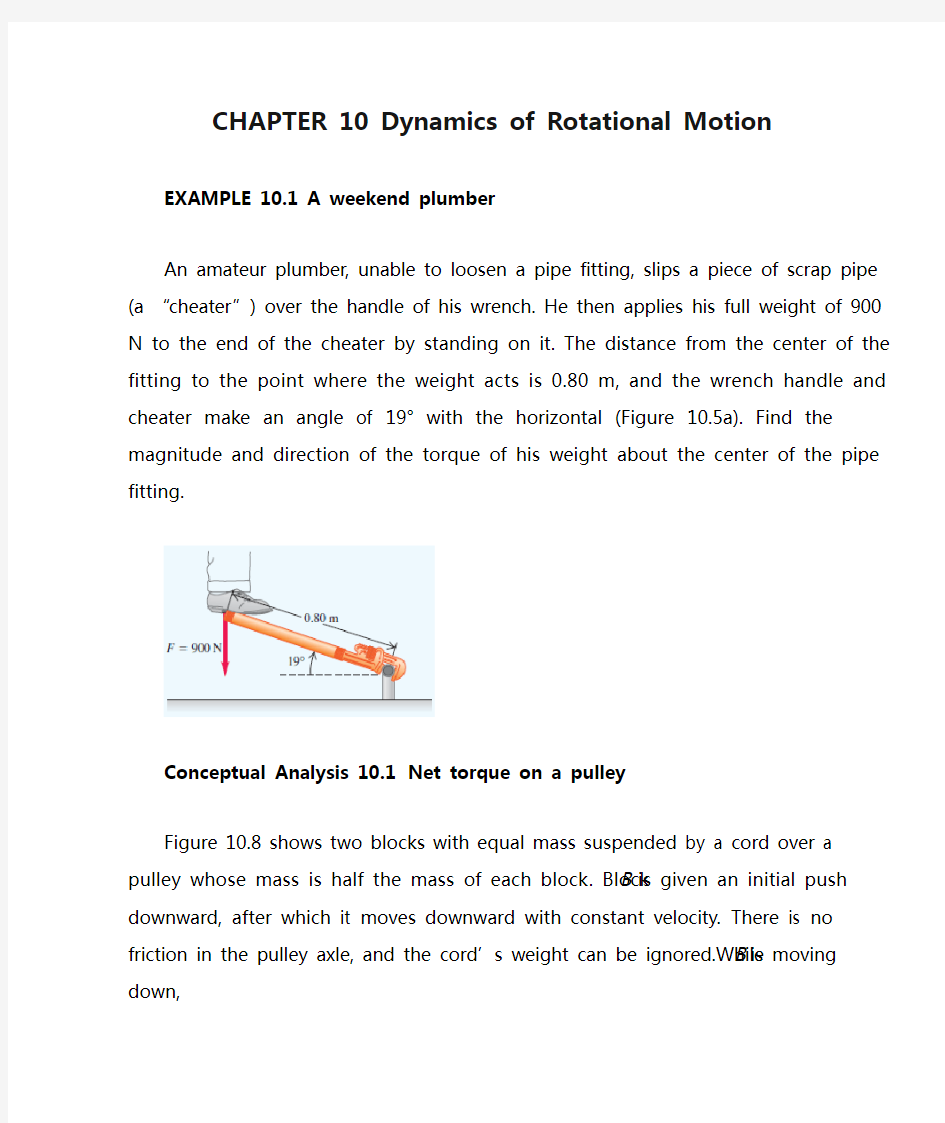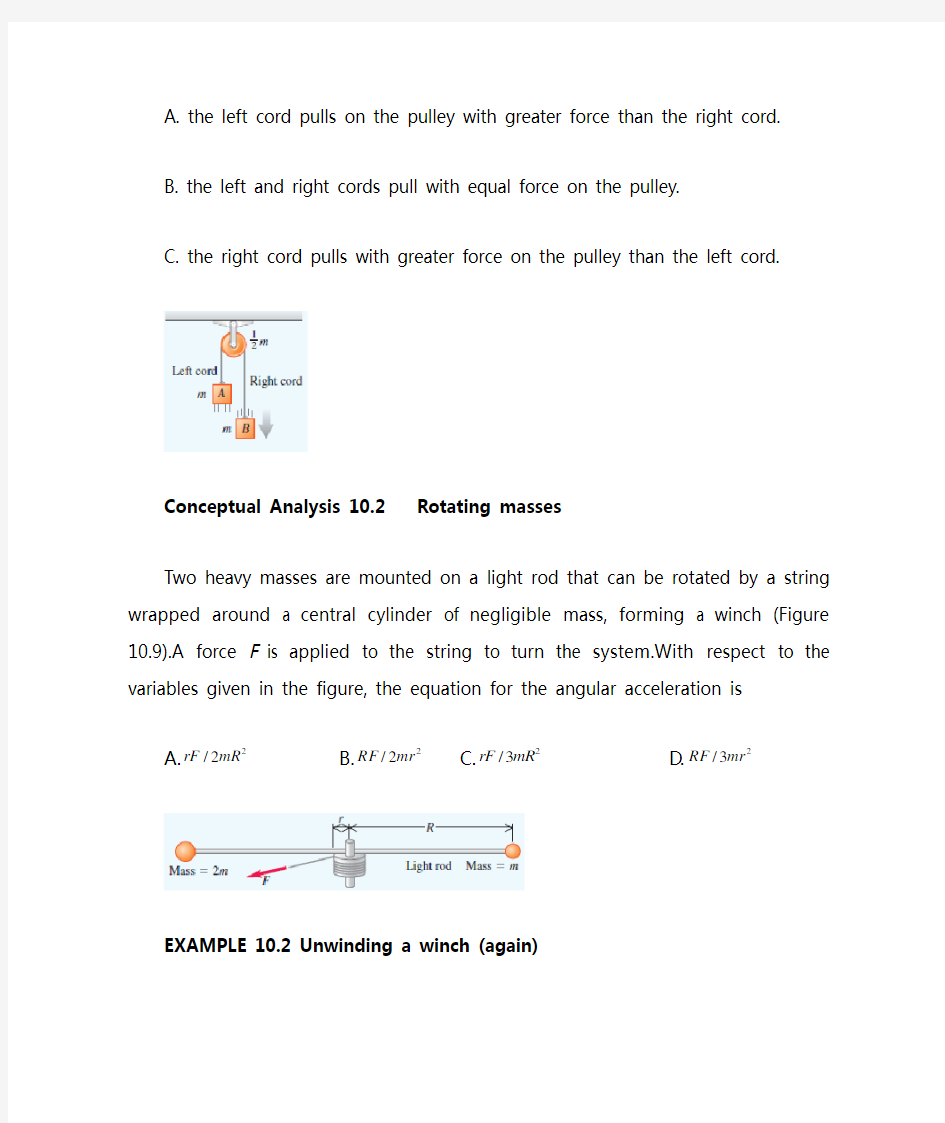CHAPTER 10 Dynamics of Rotational Motion


CHAPTER 10 Dynamics of Rotational Motion
EXAMPLE 10.1 A weekend plumber
An amateur plumber, unable to loosen a pipe fitting, slips a piece of scrap pipe (a “cheater”) over the handle of his wrench. He then applies his full weight of 900 N to the end of the cheater by standing on it. The distance from the center of the fitting to the point where the weight acts is 0.80 m, and the wrench handle and cheater make an angle of 19° with the horizontal (Figure 10.5a). Find the magnitude and direction of the torque of his weight about the center of the pipe fitting.
Conceptual Analysis 10.1 Net torque on a pulley
Figure 10.8 shows two blocks with equal mass suspended by a cord over a pulley whose mass is half the mass of each block. Block B is given an initial push downward, after which it moves downward with constant velocity. There is no friction in the pulley axle, and the cord’s weight can be ignored.While B is moving down,
A. the left cord pulls on the pulley with greater force than the right cord.
B. the left and right cords pull with equal force on the pulley.
C. the right cord pulls with greater force on the pulley than the left cord.
Conceptual Analysis 10.2 Rotating masses
Two heavy masses are mounted on a light rod that can be rotated by a string wrapped around a central cylinder of negligible mass, forming a winch (Figure 10.9).A force F is applied to the string to turn the system.With respect to the variables given in the figure, the equation for the angular acceleration is
A.22/mR rF
B.22/mr RF
C.23/mR rF
D.2
3/mr RF
EXAMPLE 10.2 Unwinding a winch (again)
Figure 10.10a shows the same situation that we analyzed in Example 9.7. A cable is wrapped several times around a uniform solid cylinder with diameter 0.12 m and mass 50 kg that can rotate freely about its axis.The cable is pulled by a force with magnitude 9.0 N. Assuming that the cable unwinds without stretching or slipping, find the magnitude of its acceleration.
EXAMPLE 9.8 Conservation of energy in a well
In an old-fashioned well, a bucket is suspended over the well shaft by a winch and rope (Figure 9.19). The winch includes a solid cylinder with mass M and radius R and rotates without friction about a horizontal axis. The bucket (mass m) must descend a height h to reach the water; it is suspended by a rope of negligible mass that wraps around the winch. If the winch handle falls off, releasing the bucket to fall to the water, rotating the cylinder as it falls, find the speed of the bucket and the angular velocity of the cylinder just before the bucket hits the water.
Let’s go back to the old-fashioned well in Example 9.8. Find the acceleration of the bucket (mass m) and the angular acceleration of the winch cylinder.
EXAMPLE 9.9 A primitive yo-yo
Figure 9.22 shows a primitive (and not very practical) yo-yo in the form of a solid disk with radius R and total mass M. It is released from rest, the supporting hand is stationary, and
v of the center of the string unwinds without slipping. Find an expression for the speed
cm
mass of the solid cylinder after it has dropped a distance h.
Let’s consider again the yo -yo we analyzed in Example 9.9. As shown in Figure 10.12a, the yo-yo consists of a solid disk with radius R and mass M . In our previous analysis, we used energy considerations to find the yo-yo’s speed after it had dropped a certain distance. Now let’s find the acceleration of the yo -yo and the tension in the string (which we can’t do by using energy considera tions alone).
EXAMPLE 10.5 A rolling bowling ball
A bowling ball rolls without slipping down the return ramp at the side of the alley (Figure 10.13a). The ramp is inclined at an angle β to the horizontal. What is the ball’s acceleration? What is the friction force acting on the ball? Treat the ball as a uniform solid sphere, ignoring the finger holes.
EXAMPLE 10.6 Power of an electric motor
An electric motor exerts a constant torque of m N 10?=τ on a grindstone mounted on its shaft; the moment of inertia of the grindstone is 2
0.2m kg I ?=. If the system starts from rest, find the work done by the motor in 8.0 s and the kinetic energy at the end of this time. What was the average power delivered by the motor?
EXAMPLE 10.7 A kinetic sculpture
A part of a mobile suspended from the ceiling of an airport terminal building consists of two metal spheres,each with mass 2.0 kg, connected by a uniform metal rod with mass 3.0 kg and length s=4.0m.The assembly is suspended at its midpoint by a wire and rotates in a horizontal plane, making 3.0 revolutions per minute. Find the angular momentum and kinetic energy of the assembly.
EXAMPLE 10.8 Two rotating disks interacting
Figure 10.20 shows two disks, one an engine flywheel, the other a clutch plate attached to a transmission shaft. Their moments of inertia are A I and B I ; initially, they are rotating with constant angular velocities A ω and B ω, respectively. We then push the disks together with forces acting along the axis, so as not to apply any torque on either disk. The disks rub against each other and eventually reach a common final angular velocity f ω.Derive an expression for f ω.
Conceptual Analysis 10.3 Mass on a string: I
In Figure 10.21, a block slides in a circular path on a horizontal frictionless plane under the action of a string that passes through a hole in the plane and is held vertically underneath it. By pulling on the lower end of the string, we reduce the radius to half of its original value. If the initial speed of the block is i v , then the speed of the block after the string is shortened is A.i v 2
1 B.i v
2 C.i v 4
QConceptual Analysis 10.4 Mass on a string: II
Let’s consider again the whirling block shown in Figure 10.21. By letting additional string pass through the hole in the plane, we increase the radius to twice its original value. If the initial tension in the string is T , then the tension in the string after the radius is increased is A.T 21 B.T 41 C.T 8
1 EXAMPLE 10.9 Anyone can be a ballerina
An acrobatic physics professor stands at the center of a turntable, holding his arms extended horizontally, with a 5.0 kg dumbbell in each hand (Figure 10.22). He is set rotating about a vertical axis, making one revolution in 2.0 s. His moment of inertia (without the dumbbells) is 3.0kg·m2 when his arms are outstretched, and drops to 2.2 kg·m2 when his arms are pulled in close to his chest. The dumbbells are 1.0 m from the axis initially and 0.20 m from it at the end. Find the professor’s new angular velocity if he pulls the dumbbells close to his chest, and compare the final total kinetic energy with the initial value.
EXAMPLE 10.10 Angular momentum in a crime bust
A uniform door 1.0 m wide with a mass of 15 kg is hinged at one side so that it can rotate without friction about a vertical axis. The door is unlatched. A police detective fires a bullet with a mass of 10 g and a speed of 400m/s into the exact center of the door in a direction perpendicular to the plane of the door. Find the angular velocity of the door just after the bullet embeds itself in it. Is kinetic energy conserved?
EXAMPLE 10.11 Playing on a seesaw
You and a friend play on a seesaw. Your m ass is 90 kg, and your friend’s mass is 60 kg. The seesaw board is 3.0 m long and has negligible mass. Where should the pivot be placed so that the seesaw will balance when you sit on the left end and your friend sits on the right end?
EXAMPLE 10.12 A heroic rescue
Sir Lancelot is trying to rescue the Lady Elayne from the Black Castle by climbing a uniform ladder that is 5.0 m long and weighs 180 N. Lancelot, who weighs 800 N, stops a third of the way up the ladder (Figure 10.26a). The bottom of the ladder rests on a horizontal stone ledge and leans across the castle’s moat in equilibrium against a vertical wall that is frictionless because of a thick layer of moss. The ladder makes an angle of 53°with the horizontal, conveniently forming a 3–4–5 right triangle. (a) Find the normal and friction forces on the ladder at its base. (b) Find the minimum coefficient of static friction needed to prevent slipping. (c) Find the magnitude and direction of the contact force on the ladder at the base.
EXAMPLE 10.13 Equilibrium and pumping iron
Figure 10.27a shows a human arm lifting a dumbbell. The forearm is in equilibrium under the action of the weight w of the dumbbell, the tension T in the tendon connected to the biceps muscle at point A , and the forces exerted on the forearm by the upper arm at the elbow joint. For clarity, the tendon force has been displaced away from the elbow farther than its actual position. The weight w and the angle are given. Find the tension T in the tendon and the two components of force (x E and y E ) at the elbow (three unknown quantities in all). Neglect the weight of the forearm itself. Evaluate your results for ,10.0,50m d N w ==m l 50.0=,and ?=80θ.
EXAMPLE 10.14 A laboratory gyroscope
Figure 10.32 shows a top view of a gyroscope wheel in the form of a solid cylinder,driven by an electric motor. The pivot is at O, and the mass of the axle and motor are negligible. Is the precession clockwise or counterclockwise, as seen from above? If the gyroscope takes 4.0 s for one revolution of precession, what is the wheel’s angular velo city?
